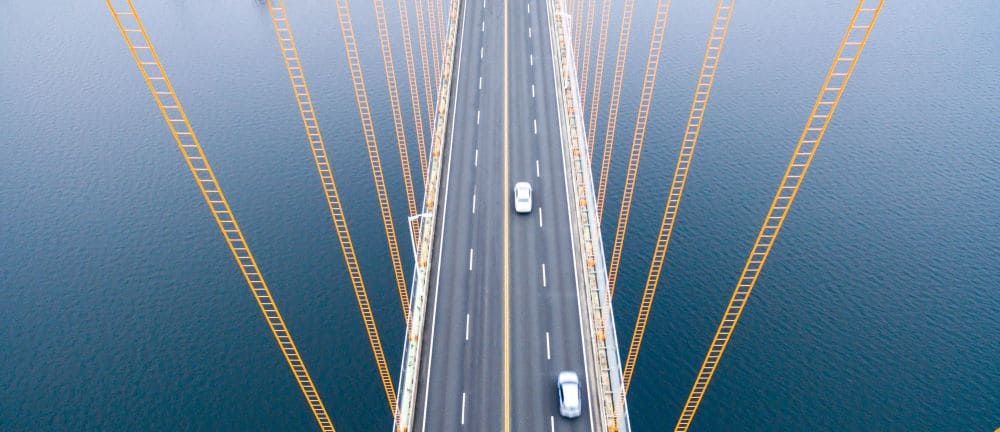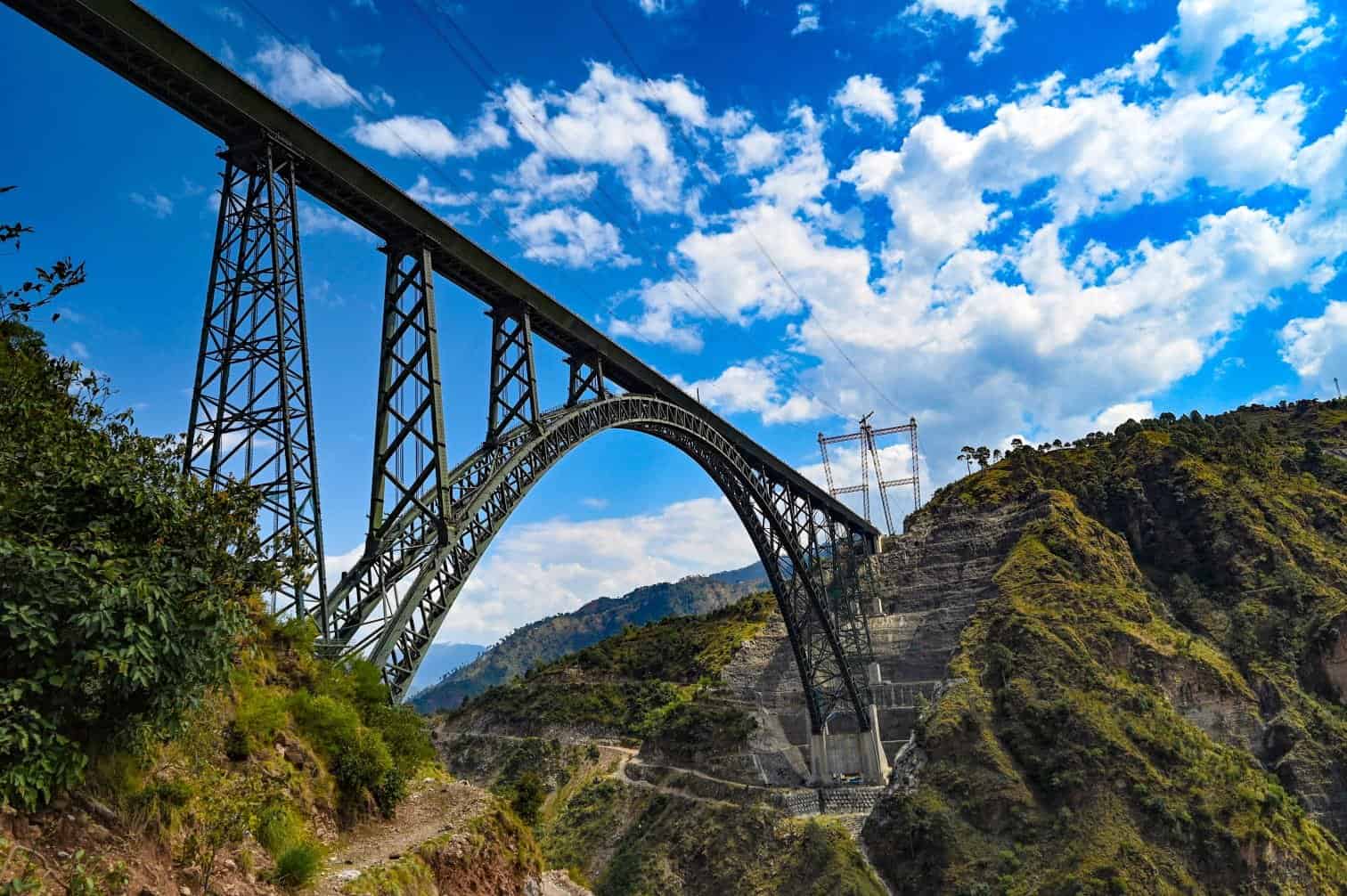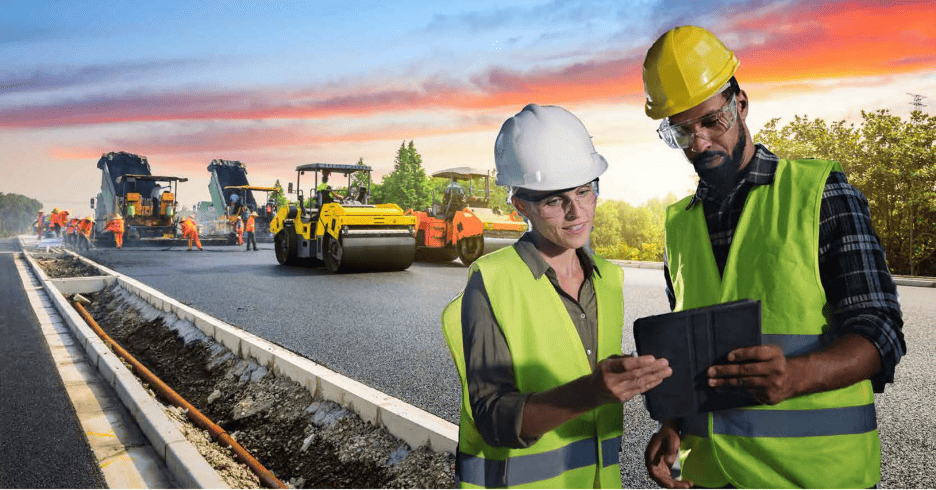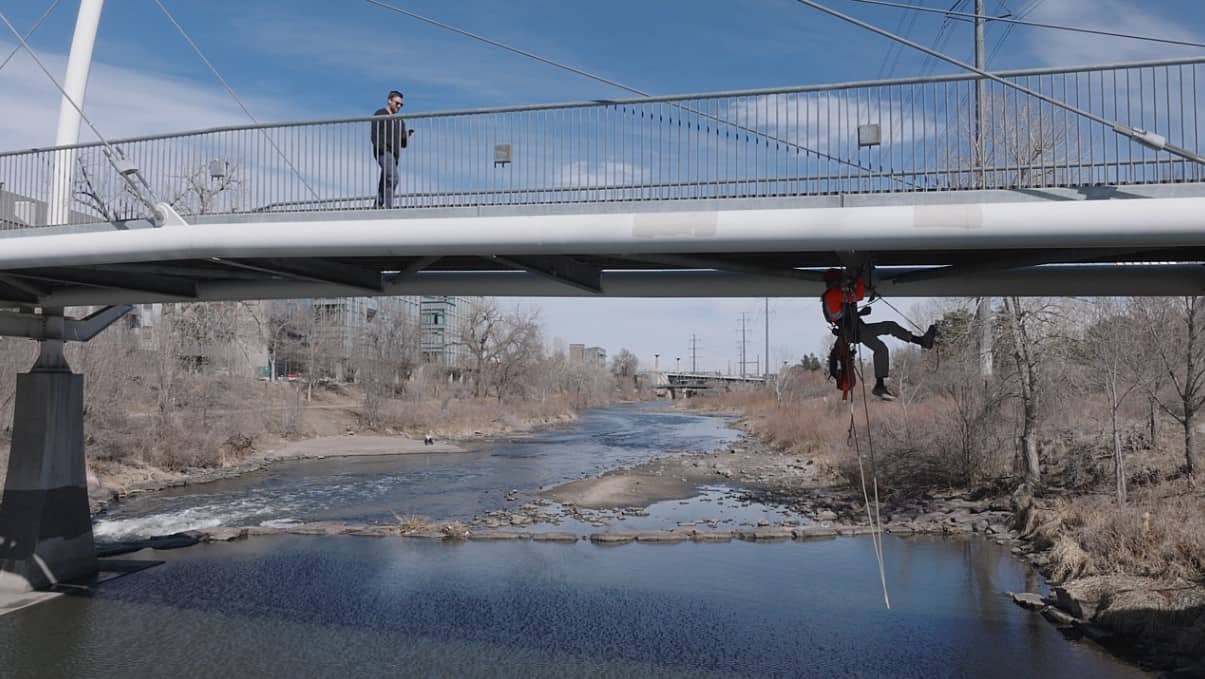On July 28th, 2022, Eastern Kentucky experienced historic flooding that took the lives of 40 people and caused significant damage to homes, roads, and bridges. The natural topography of the region includes narrow valleys, steep hillsides and small strips of land with homes and roads. Access in and out can be challenging, as many residents rely on one bridge for their only connection. Those that were fortunate enough to survive the flooding had to face the challenge of getting food, medical care, and driving to work on destroyed or compromised roads and bridges. In some cases, the residents of Eastern Kentucky are still dealing with this reality and will for some months if not years to come.
Unfortunately, the events of Eastern Kentucky are not unique and bridge collapses around the globe have recently made headlines in India, Italy, and Mexico City. Some of these tragic failures are not the result of extreme weather events but are attributed to structures extending beyond their useful design life.
Who’s Responsible for Aging Infrastructure?
Many of us drive across bridges every day but seldom think about the possibility of the bridge not being there and how it would impact our daily lives. We are fortunate that bridge damage or collapses are a rare occurrence, and we are afforded the luxury of crossing bridges with little concern for our safety.
The confidence we have in bridges is in large part due to professionals who have dedicated their careers to ensuring that these structures are safe. Inspectors and operators of this infrastructure undoubtedly take this responsibility very seriously and realize that they carry the burden of public safety every day they go to work. It should be concerning to all of us that organizations responsible for maintaining infrastructure are experiencing labor shortages at a time when many bridges are beyond their design life and in desperate need of rehabilitation or replacement.
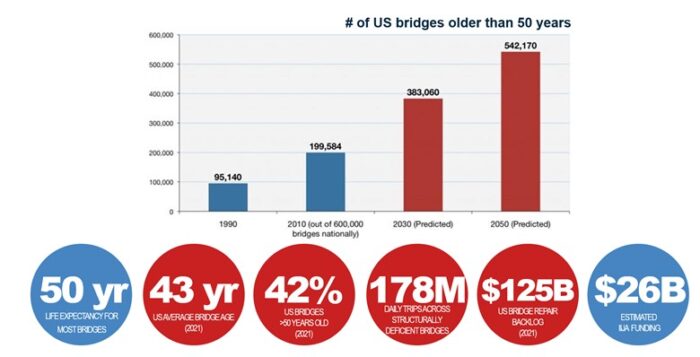 Image courtesy of Transportation for America.
Image courtesy of Transportation for America.The burden of public safety combined with diminished resources and an increasing workload is not a good combination for the inspectors or the public. The number of news stories relating to deficient bridges are all too frequent and statistics on aging infrastructure present a daunting problem for the industry. How can the industry as a whole approach this with a systematic solution? Is there a better process for identifying defects before they become critical? How can we prioritize repairs and replacement in a large transportation network? How do we address a labor shortage in an inherently labor-intensive process?
A problem of this scale requires a multi-faceted approach and the attention of all stakeholders involved; the agencies and individuals directly responsible for the bridges as well as the public, who can hold electable officials accountable for funding repairs are all part of the solution.
Bridging the Gap with Digital Twins, Drones, and Sensors
Technology is advancing, allowing inspectors to reduce time spent onsite. These advances change the dynamic of how processes are completed, forcing teams to reevaluate how resources are allocated and how workflows are distributed. For example, inspections have typically been physical onsite visual activities completed by workers who have years of field experience. The use of tools like drones, sensors, and artificial intelligence can augment the work that inspectors are doing onsite. We recently asked a few of our users about how these rapid advances in technology are impacting both the nature and outcome of their work:
Benesch
Using data collected by drones in combination with artificial intelligence is something that professional services firm Benesch is finding particularly useful, allowing them to extract and compute data on bridge crack detection— a traditionally manual process that can be very difficult and time-consuming. AI workflows saved significant time and provided higher-quality data compared with manual processes, leading to improved decision-making. Bret Tremblay, a Technical Manager with Benesch’s Kansas division involved with the company’s drone programs and visualization initiatives, says “This technology allows us to bring the workflow into the office so that inspections can be assisted, aided, or in some cases done from in the office, which really benefits us in situations such as hazardous conditions or hard-to-reach locations.”
Digital twins are being used by Benesch throughout the life of their projects. The 3D models are being brought into different reality states such as augmented reality and incorporated into team workflows and collaboration methods. Using augmented reality provides an immersive view of the bridge that previously would only be seen onsite and, in some cases, would be difficult to see with a snooper truck alone. This type of immersive experience provides a collaborative environment for the team, improved insight into asset data, and, in turn, improved decision-making for future maintenance or rehabilitation activities.
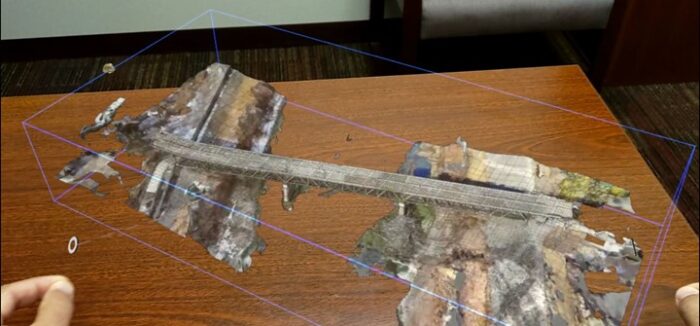 Augmented reality being used for remote bridge inspection. Image courtesy of Benesch.
Augmented reality being used for remote bridge inspection. Image courtesy of Benesch.West Virginia Division of Highways
West Virginia’s Division of Highways started looking at digital twin technology along with photogrammetry and drones over 10 years ago. In 2017 they began using Bentley’s ContextCapture along with drones on several projects starting with stockpiled inventory. They were quickly able to show a return on investment for over 170 sites and saved over $342,000 in labor costs during the first month of use.
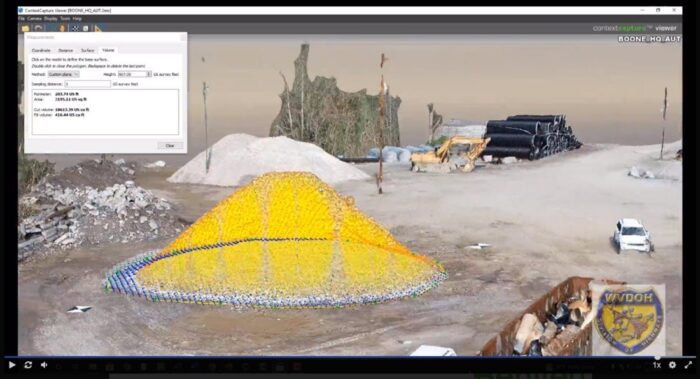 Reality model of West Virginia stockpiled inventory. Image courtesy of West Virginia Division of Highways.
Reality model of West Virginia stockpiled inventory. Image courtesy of West Virginia Division of Highways.The technology is now being used for interim inspections on bridges, augmenting the physical inspections carried out by the bridge inspectors. Travis Long is Director of the Technical Support Division at West Virginia Division of Highways and, given his responsibility for UAV programs, surveying, and mapping, plays a key role in this process. Long shares “For interim inspections, every time you don’t have to use a snooper truck -which requires lane closures and can create traffic and safety issues- there are real benefits for both us and the community.”
The state has about 20 drones and has found many good use cases for digital twins, drones, and sensors. They have also found that the use of AI helps eliminate human error in these kinds of activities. Long notes that bridges are some of the most difficult assets to model, collect data for, and work with because they require such rich 3D photos and data. He shares that creating a high-fidelity model in which users can identify and label issues and then view them in a unified environment “improves a lot of different issues that we’ve had with bridge inspections in the past.”
Collins Engineers
Collins has been using digital twin technology on projects for the past several years. Combining IoT and sensor data with a digital twin gives Collins the ability to make data readily available to everyone in context so that they can use that data to make decisions about the bridges.
Using Bentley’s reality modeling and digital twin applications, they performed virtual inspections and established a mixed reality environment for the team and public to view a digital twin of the iconic Stone Arch Bridge in Minneapolis, Minnesota. This process also helped provide stakeholders with a better understanding of the restorative design works. Traditionally, inspection notes were recorded and communicated using pencil and paper accompanied by photos. While necessary to augment onsite inspections, teams couldn’t solely rely on this approach because it lacked the detail needed to make definitive decisions and safely complete the project. However, the 3D digital twin enables the field team to inspect the bridge remotely, record their findings directly on it, and accurately pinpoint the areas in need of repair.
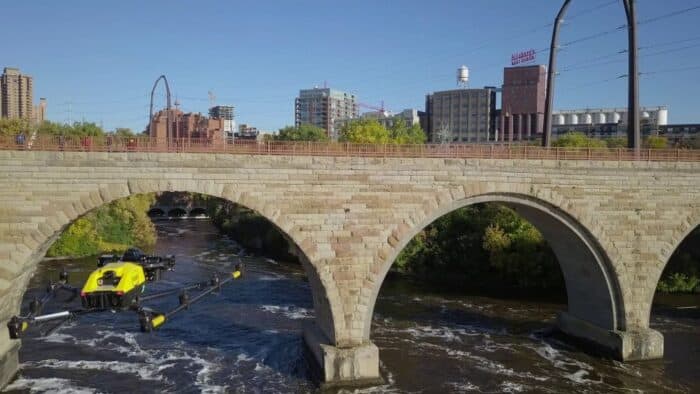 Drones are increasingly being used to capture bridge data used to create reality models or for purposes of monitoring and inspection. Image courtesy of Collins Engineering.
Drones are increasingly being used to capture bridge data used to create reality models or for purposes of monitoring and inspection. Image courtesy of Collins Engineering.Barritt Lovelace, Vice President of UUAS, AI and Reality Modeling with Collins Engineers says “We’re automating collecting the data using drones. We’re automating processing the data and making the data much more accessible and usable to our project teams.”
Breaking Down Data Silos
Core to these users’ success is their ability to utilize data. By adopting a digital strategy and a data-centric approach, the data contained in their files is unlocked and made available to the right person at the right time to make better-informed decisions, leading to better outcomes.
Bentley’s iTwin Platform was recently extended with new products and workflows that help bring data-centric benefits to bridge monitoring and inspection workflows. These new products include the ability to create 3D reality meshes of a bridge (iTwin Capture), gather real-time sensor data and insights (iTwin IoT), as well as visualize, query, and analyze infrastructure Digital Twins in their full context (iTwin Experience).
Our asset-specific solution for bridge monitoring and inspection incorporates these products and others to enable users to leverage a reality mesh to augment bridge inspection processes, tag condition notes directly in the 3D environment, and remotely review the condition of the structure. AI/ML defect detection allows you to automatically identify and classify defects in the field. Inspection data required to correct issues can be seamlessly handed over to maintenance, design, and construction workflows to create substantial savings.
Bentley Chief Executive Officer Nicholas Cumins describes the move to data-centricity that these products and solutions help facilitate as “shifting from a fragmented and limited understanding of an infrastructure asset to a single view of truth that multiple groups can access. Data that is no longer static and locked up but kept evergreen.”
Beyond the role that data plays in helping to better design, build, and operate better infrastructure, data can also play a role in bringing new funding to bridge rehabilitation projects. With technology changing how projects are completed, there may be opportunities for Federal Smart Grants to be obtained that provide resourcing to supplement inspection crews and further reduce the backlog of deteriorating assets. Funding for these projects needs to keep up with or surpass the rate at which the assets are deteriorating. It is incumbent on agencies to better communicate these needs to those administrative officials responsible for the funding. How can this be accomplished? Acquiring and maintaining more accurate data on the status of infrastructure and presenting it in a clear and concise manner is a good place to start.
The bottom line: Everyone will be better off if we can move towards more data-centric decisions driving the allocation of resources and away from tragic headlines driving reactive spending.
Hear more about how Benesch and West Virginia’s Division of Highways are using digital twins in their bridge workflows via this webinar.
Learn more about Bentley’s bridge monitoring and inspection solution here.

